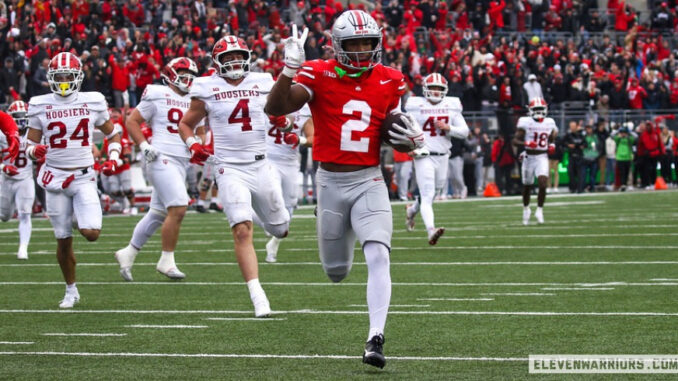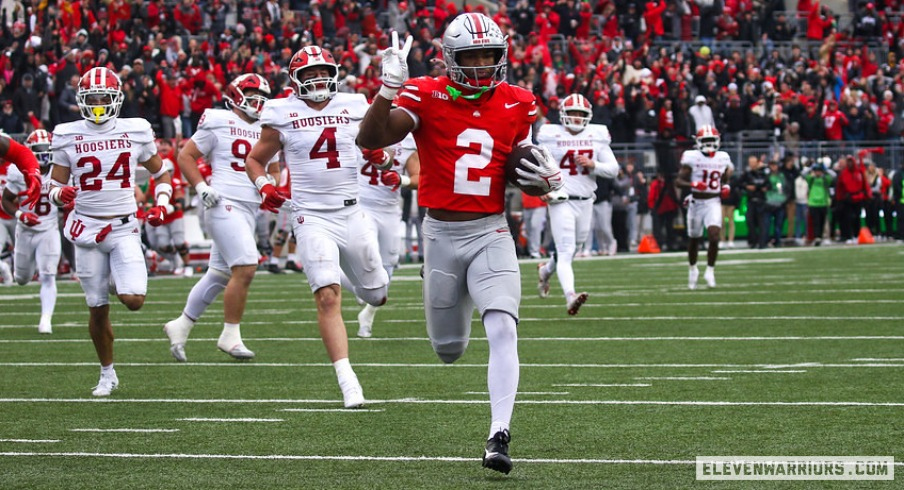
Ohio State Has a Former 5-Star Changing Positions This Spring: Buckeye Bits
In the world of college football, changes are a constant, whether it’s a shift in coaching staff, a top recruit emerging as a key player, or, as is the case for Ohio State this spring, a highly regarded player changing positions. In what has become a topic of intense interest among Buckeye fans, a former 5-star recruit is making the transition to a new position as part of the Ohio State football team’s efforts to strengthen its roster and improve its depth heading into the 2025 season.
Position changes are not uncommon in college football, and they often come with significant adjustments for both the player and the team. However, when a player with the pedigree of a former 5-star recruit is involved, the spotlight shines even brighter. The decision to switch positions, particularly for someone with such high expectations, can shape the future trajectory of both the player’s career and the program as a whole.
In this article, we’ll dive into the background of the player involved in this position change, the impact it will have on Ohio State’s depth chart, how the change reflects broader trends in college football, and what it could mean for the Buckeyes going forward. This position switch could be pivotal for the Buckeyes, and understanding the nuances of this move will give fans insight into how Ohio State plans to maintain its position as a national contender in the coming seasons.
1. The Player Behind the Change: A Former 5-Star Recruit
The player at the center of this spring’s position change at Ohio State is none other than Trevor Williams, a former 5-star recruit who joined the Buckeyes with immense expectations following his high school career. Williams, a highly decorated high school prospect from Florida, was widely regarded as one of the top athletes in his recruiting class. He had all the physical attributes to make an immediate impact at Ohio State and was expected to be a key contributor early in his college career.
During his high school years, Williams was a standout athlete, excelling both on the football field and in track and field. With a combination of size, speed, and athleticism, he was recruited by top programs across the country. Williams played both wide receiver and defensive back in high school, showcasing his versatility and ability to contribute on either side of the ball. This versatility was part of what made him such an attractive prospect, and Ohio State saw him as a player who could make an immediate impact as a wide receiver or cornerback, depending on how the program needed him.
When he arrived in Columbus, Williams began his Ohio State career as a wide receiver, where he was expected to add depth to a talented but relatively young receiving corps. Ohio State’s wide receiver room was loaded with talent, but Williams was viewed as a potential future star. His combination of size (6’2″, 205 pounds) and speed made him an ideal candidate to be molded into a big-play threat for the Buckeyes. However, as his freshman season progressed, it became clear that the team’s receiving depth was more competitive than originally anticipated, and Williams found himself buried on the depth chart behind established players.
After a few seasons of limited playing time, Williams started to struggle with the challenge of carving out a role as a wide receiver in a highly competitive group. While his raw talent was undeniable, it became apparent that the team’s offensive system and the presence of other playmakers meant Williams was not making the immediate impact that many had envisioned.
2. Why the Position Change? Understanding the Motivation Behind the Move
The decision for Williams to change positions is one that has been in the works for some time, as the coaching staff recognized that Williams might be better suited for a new role. The shift comes after a period of reevaluation for both Williams and the coaching staff, where it became clear that his skill set and physical attributes could be more effectively utilized elsewhere on the field. Williams has reportedly been working with the coaching staff this spring to transition from wide receiver to cornerback—a move that reflects both his versatility and the Buckeyes’ need for depth in the secondary.
So why switch positions now? The answer is multifaceted, involving both personal and team-related considerations.
1. Position of Need
Ohio State’s defensive backfield is one area where depth and development have been major concerns in recent seasons. The Buckeyes have had their fair share of strong cornerbacks, but with the departures of key veterans to the NFL, there’s an urgent need for talented players who can step up and make an immediate impact. Cornerback, in particular, has become a position of need as the program looks to develop more playmakers in the secondary, and Williams’ switch to cornerback could help fill that void.
The Buckeyes have struggled at times with coverage against top-tier receivers, and although the defensive backfield has had bright spots, adding another highly athletic player with Williams’ size and skills to the cornerback room could provide a big boost. Ohio State’s defense, under defensive coordinator Jim Knowles, has placed a premium on versatility and the ability to adapt, and Williams’ athleticism and high football IQ make him an intriguing prospect for this transition.
2. Maximizing Williams’ Talents
For Williams, the move to cornerback may represent the best opportunity to showcase his skills and make the kind of impact that was expected of him when he first arrived at Ohio State. Despite his early struggles as a wide receiver, Williams has always had the physical tools to excel on defense. His speed, agility, and ball skills are traits that translate well to cornerback, where he will be asked to cover fast, dynamic receivers and make plays on the ball.
Additionally, cornerback is a position that allows Williams to leverage his natural athleticism and ability to track the football in space. His experience as a wide receiver could also serve as an advantage, as he’s likely to have a strong understanding of the types of routes and movements he’ll be facing from opposing receivers. This knowledge could give him an edge in coverage, allowing him to anticipate plays more effectively.

3. Coaching and Development Philosophy
The coaching staff at Ohio State is known for being innovative in its approach to player development, and the switch to cornerback aligns with that philosophy. Head coach Ryan Day and defensive coordinator Jim Knowles have both expressed their commitment to player development and their belief in giving athletes the best chance to succeed, even if that means switching positions. They have shown a willingness to be flexible and creative in finding roles for their players, and Williams’ move to cornerback is just the latest example of this.
From a coaching standpoint, Ohio State believes that Williams has the potential to be a key contributor in the secondary. The program’s depth and development at the cornerback position are crucial for maintaining competitiveness, and if Williams can make the transition smoothly, he could become an integral part of Ohio State’s defensive game plan.
3. The Impact on the Depth Chart and Team Chemistry
Williams’ position change also has significant implications for Ohio State’s depth chart, particularly in the defensive backfield. Cornerback is a position where Ohio State has needed to develop more depth, and Williams’ transition could immediately address that need. With the Buckeyes looking to reload after losing several key players to the NFL, adding a former 5-star recruit with Williams’ physical tools is a move that could help the team immensely.
In addition to the immediate benefits for the defense, Williams’ move also demonstrates the flexibility and adaptability that Ohio State’s coaching staff values. While Williams was a highly ranked recruit as a wide receiver, the program is willing to make a bold move to get the best out of his talents. The success of this position change could set a precedent for other athletes within the program to explore new roles, whether out of necessity or a desire to maximize their skill set.
Another key element of this move is the impact it could have on the team’s chemistry and camaraderie. Position changes often come with a learning curve, and the coaching staff will need to ensure that Williams integrates smoothly into the secondary while maintaining positive relationships with his former teammates in the wide receiver room. This transition is not just a personal challenge for Williams; it’s also a collective effort as the entire team adjusts to the changes.
4. What to Expect From Trevor Williams in 2025
The 2025 season promises to be an exciting one for both Williams and Ohio State fans. Williams will have the opportunity to prove that his move to cornerback was the right decision, and he could quickly become a key contributor to Ohio State’s defensive unit. His athleticism and football IQ give him the potential to thrive in the secondary, and if he can master the technical aspects of playing cornerback, Williams could quickly become one of the most promising defensive backs in the Big Ten.
As for Ohio State, the switch represents a forward-thinking approach to player development and a recognition of the evolving needs of the team. The Buckeyes are looking to continue their dominance on both sides of the ball, and adding Williams to the mix could help bolster a defense that has shown promise but needs more playmakers to take the next step.
A Bold Move for the Future
Trevor Williams’ decision to switch positions from wide receiver to cornerback represents a bold move for both him and the Ohio State football program. As a former 5-star recruit, Williams carries high expectations, and his transition to a new position provides both challenges and opportunities. If successful, the move could benefit the Buckeyes in their quest for a national title, adding depth and versatility to the defensive backfield and potentially elevating the program’s defense to the level it needs to be to compete with the best teams in the country.
For Ohio State, this change reflects a willingness to be flexible and adapt, a trait that has served the program well in the past and could continue to do so in the future. As the 2025 season approaches, all eyes will be on Williams to see how he handles the switch and how it impacts the Buckeyes’ chances for success. If everything falls into place, Williams could become a key figure in Ohio State’s defense for years to come, helping the Buckeyes continue their quest for greatness.

Leave a Reply